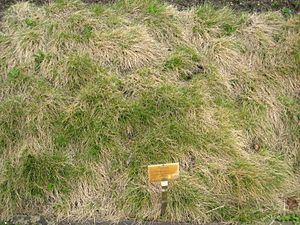Viviparous sheep's-fescue facts for kids
Quick facts for kids Viviparous sheep's-fescue |
|
|---|---|
 |
|
| Scientific classification | |
| Genus: |
Festuca
|
| Species: |
vivipara
|
The viviparous sheep's-fescue (scientific name: Festuca vivipara) is a special type of grass. You can find it growing naturally in cold places like northern Europe, northern Asia, and chilly parts of North America.
Its name, vivipara, comes from Latin. It means 'live-bearing' because, instead of making regular seeds, its flowers often turn into tiny leafy sprouts! This is a unique way for the plant to reproduce.
What it Looks Like
This grass is a perennial plant, meaning it lives for more than two years. It grows in thick clumps and can reach a height of about 5 to 20 centimeters (2 to 8 inches). That's not very tall, usually shorter than a ruler!
The stems, called culms, are thin and hair-like. The plant's leaves are somewhat stiff and narrow, like tiny blades. If you looked at a cross-section of a leaf under a microscope, you'd see it's quite small, usually less than a millimeter wide.
One of the most interesting things about Festuca vivipara is its flowers. Instead of typical flowers that produce seeds, they often change into small, leafy tufts. These tufts can then fall off and grow into new plants. This is why it's called "viviparous" – it gives birth to new plantlets directly!
This grass usually "flowers" (or produces its leafy tufts) from July into early August.
Where it Grows
You can find Festuca vivipara in many cold regions around the world. In North America, it grows in places like Greenland, Labrador, and Alaska. It likes to grow on rocky ground that has calcium in it, or in peaty soil, which is made of decaying plants. You might also spot it in western Newfoundland, the Chic-Choc Mountains, and parts of Quebec.
Outside of North America, this grass is found in northern Europe and Russia. It often grows near lakes and streams, where the ground is moist.
Different Types
Just like there can be different breeds of dogs, there are slightly different types of Festuca vivipara. Scientists call these "subspecies." The two main ones are:
- Festuca vivipara ssp. glabra
- Festuca vivipara ssp. hirsuta
These subspecies might have small differences in their appearance, like whether their leaves are smooth or slightly hairy.

